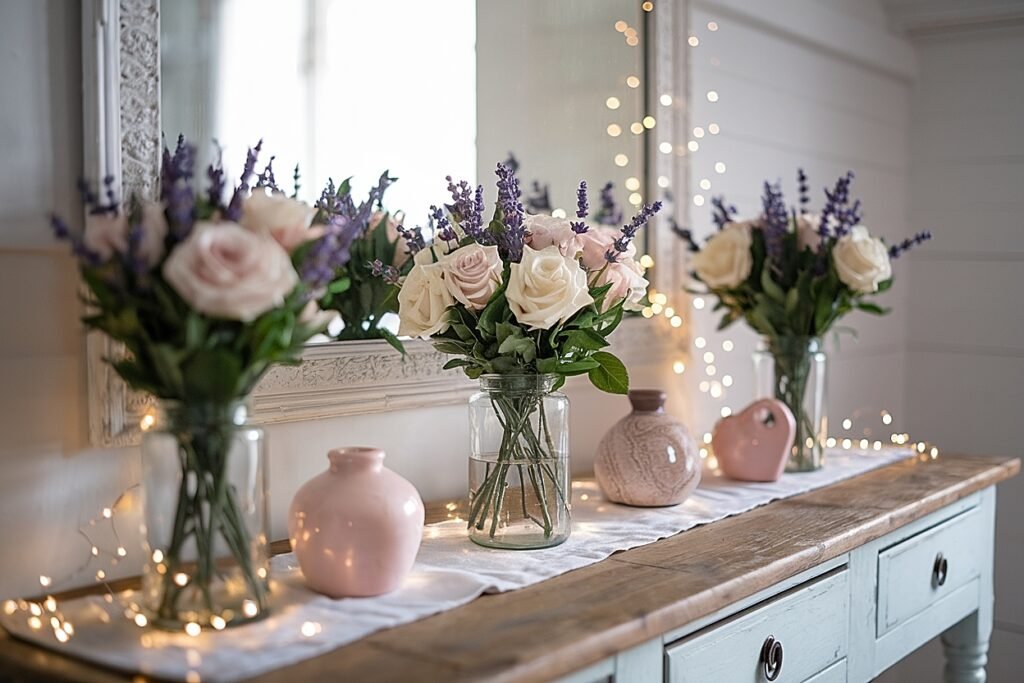
This website contains affiliate links, and some products are gifted by the brand to test. As an Amazon Associate, I earn from qualified purchases. Some of the content on this website was researched and created with the assistance of AI technology.
Key Takeaways
- Lavender cools the Christmas palette and adds calming fragrance; roses bring structure, romance, and instant focal points.
- Layer greens → structure → focal roses → lavender → accents (lights, ornaments, ribbon) for designer-level balance.
- Keep stems short, wire everything, and scale color, light, and accessories to your sideboard’s length and sightlines.
Christmas Sideboard Styling with Lavender and Roses earns its place because scent, silhouette, and light meet in one small stage. A sideboard isn’t a dumping ground; it’s the room’s thesis sentence. Lavender brings serenity and a cool tonal thread, while roses deliver sculptural impact you can read from the doorway.
I build sideboards like I build garlands for clients: generous, wired, and layered. Base greens carry the weight, roses claim the spotlight, and lavender stitches everything together with a breath of herbal calm. It’s the difference between “nice” and “who styled this?”
I’ve installed this look in tight apartments and sprawling farmhouses. Every time, the same rules guide me. Keep height intentional, protect sightlines, and choose lights that whisper. Do that, and the space hums with quiet holiday confidence.
Use this quick, color-coded selector to design a sideboard that suits your room, furniture, and vibe. Compare floral recipes, ideal furniture and window placements, and finishing accents. Each row is a complete look: pick one, copy the formula, and style confidently beautiful, fragrant, guest-proof Christmas magic in minutes without stress guaranteed.
| 🎯 Style Goal | 🌸 Floral Recipe (Roses • Lavender • Greens) |
🪑 Furniture & Window Placement | ✨ Finishing Accents & Why It Works |
|---|---|---|---|
| Classic Romantic | Blush garden roses + ivory spray roses • dried lavender wands • seeded eucalyptus + Italian ruscus | Long wood sideboard centered under a picture window; mirror above to double light | Brass taper holders, pearl garland, lace runner—soft metals amplify rose glow; lavender perfumes the room without overwhelming |
| Cottagecore Cozy | Cream roses • loose dried lavender sprigs • rosemary + dusty miller | Painted buffet beside a small sash window; style in clustered mini vases at varied heights | Gingham ribbon, stacked vintage books, twine-tied napkins—storybook layers feel handmade and welcoming |
| Fresh Nordic | White roses • fine lavender buds • blue-green eucalyptus + cedar tips | Slim console under tall window; keep negative space around vessels for calm lines | Clear glass cylinders, birch slices, micro-LEDs—clean shapes echo snowy daylight and cool greens |
| Gilded Glam | Deep red roses + blush roses • lavender bunches • magnolia + bay laurel | Ornate sideboard opposite a bay window; symmetrical urns anchor the composition | Gold chargers, crystal drops, satin ribbon—a high-shine trio that spotlights luxe roses against matte lavender |
| Blue-Hour Serenity | Mauve roses • dried lavender • silver brunia + lamb’s ear | Sideboard facing west window; time styling for twilight to catch cool tones | Frosted lanterns, mercury votives—diffuse glow makes silvers shimmer and lavender read tranquil |
| Woodland Rustic | Berry-tone roses • twiggy lavender • cedar + juniper + pinecones | Chunky dresser under small cottage window; layer garland along back edge, low bowls upfront | Velvet bows, foraged cones, cinnamon—earthy scents + textures = fireside feels |
| Minimal Monochrome | All-ivory roses • pale lavender tips • olive branch | Slim metal console under clerestory windows; three vessels max, large negative space | Matte ceramics, linen runner—quiet surfaces let form and silhouette lead |
| Family-Proof Glow | Spray roses • bundled lavender sachets • eucalyptus + myrtle | Busy household? Place on wide, sturdy buffet away from low windows; keep heights modest | Flameless LED pillars, shatterproof baubles—safe sparkle, same ambience |
| Front-Window Showcase | Apricot roses • dried lavender • cypress tips + ivy trails | Deep console in front bay window; stagger heights to read from the street | Mirror tiles, metallic garland—extra reflections magnify candlelight after dark |
| Open-Plan Anchor | Mixed blush/cranberry roses • lavender • olive + eucalyptus | Long sideboard between kitchen & lounge; create visual “bridge” line that reads from both rooms | Repeating trios (vase-votive-ornament) every 24–30″—rhythm keeps big spaces tidy |
| Tiny-Space Edit | Three large roses • mini lavender bottle • single branch greenery | Narrow cabinet under a small window; vertical bud vases to save footprint | One metallic accent color only—prevents visual clutter while still feeling festive |
| Vintage Curio | Heirloom roses • lavender bundles • bay + thyme | Glass-front sideboard near east window; place florals beside displayed china | Cameo frames, lace doilies—heritage layers tie keepsakes to seasonal scent & color |
How to Style a Christmas Sideboard with Lavender and Roses
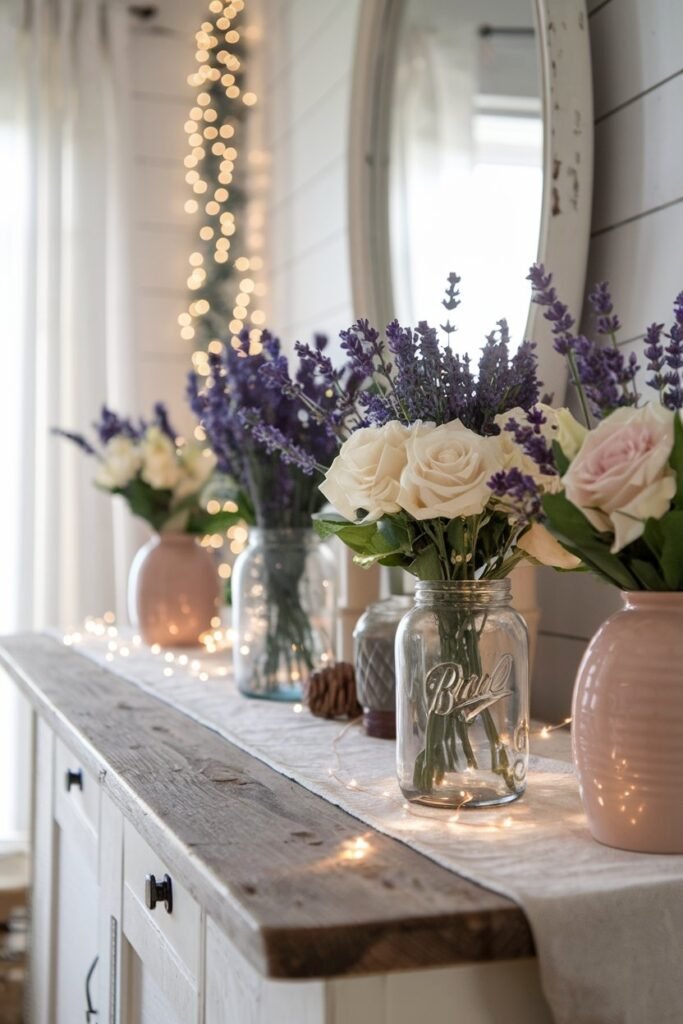
A great sideboard composition starts with proportion. I measure the surface, then plan a low-to-medium profile so guests can set plates and still enjoy the view. I sketch a loose “S” curve to guide placement: heavier at one third, lighter as it tapers. That curve keeps energy moving and prevents the dreaded flat line.
Next comes structure. I lay a spine of noble fir or cedar to hide mechanics, then wire roses on short stems (1.5–2 inches) and place them in tight clusters. I add lavender last, angled slightly outward to create lift and fragrance without sprawl.
I keep mechanics clean: paddle wire, floral tape, and discreet command hooks if I’m anchoring garland swags behind the arrangement. Seeded eucalyptus breaks up solids, boxwood plugs gaps, and juniper berries echo lavender’s cool tones. Candle light stays low and shielded.
Hint: Layer greens as a shallow base, cluster roses every 10–12 inches, then “stitch” lavender through the negative space. For a deeper dive into wiring, sequencing, and lighting around florals, see how to create a Lavender and Rose Christmas Garland, and if this guide helps, consider sharing it with a friend who’s refreshing their holiday décor. There’s more nuance ahead—keep reading for color strategies.
What Are the Best Color Combinations with Roses and Lavender for Christmas?
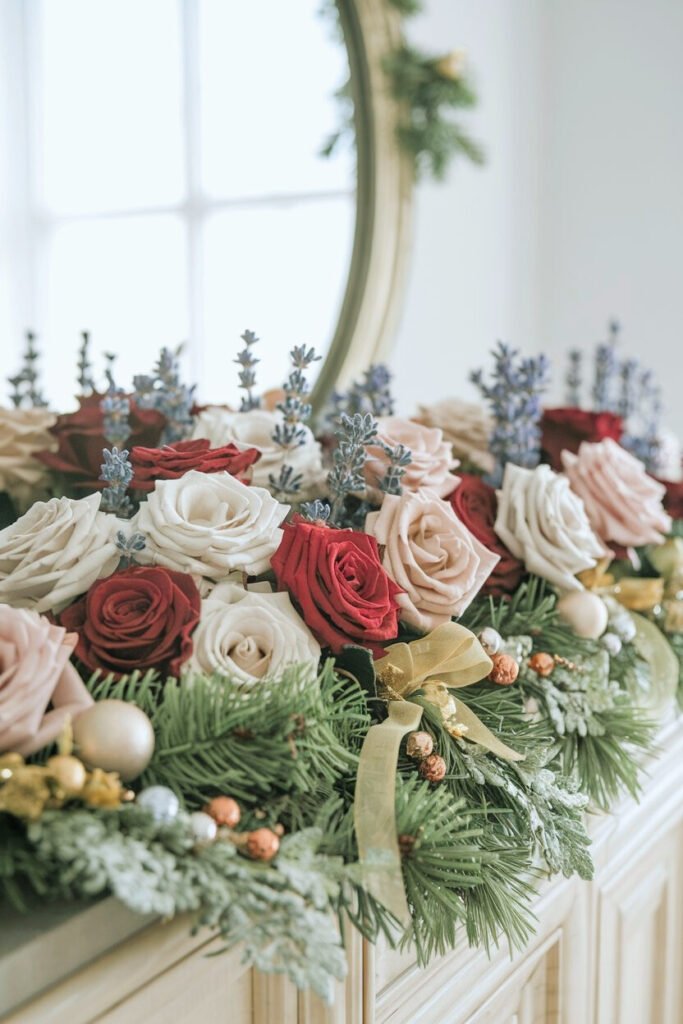
Color drives mood and readability across a room. I choose palettes that flatter lavender’s cool register and let roses glow rather than shout. Test under your actual bulbs before committing; warm LEDs can nudge blush toward peach and cool LEDs can flatten reds.
I aim for three tones: a base, a bridge, and an accent metal. That triad keeps the look complex but digestible.
- Icy Blush, Lavender, and Silver: Pair blush garden roses with lavender sprigs and silver accents. The silver cools the scene, letting lavender read smoky-violet. Use eucalyptus and juniper for tone-matching, mercury glass for quiet shimmer, and micro-LEDs on warm white to avoid clinical light. This palette suits white mantels, modern dining rooms, and spaces that want winter without chill.
- Mulled Wine, Mauve, and Soft Lavender: Anchor with claret roses, bridge with mauve spray roses, and thread lavender for relief. Bronze or smoked gold ornaments warm the mix, while cedar adds movement. Under candlelight, claret turns velvety; lavender prevents heaviness. Ideal for dark wood, vintage brass, and rooms craving old-world polish.
- Cream, Dusty Pink, and French Lavender: Cream roses make lavender luminous. Dusty pink softens transitions and keeps the scheme romantic. Use boxwood for a tailored edge, copper micro-ribbon for a gentle glow, and frosted glass to diffuse light. This palette stays pretty from morning daylight to evening LEDs.
- Bone, Heather Grey, and Chrome: For minimal interiors, go white or bone roses, heather-tinged lavender, and chrome touches. Keep greenery architectural—fir, boxwood, a hint of eucalyptus. Cool LEDs can work here; restraint is the magic. Negative space becomes part of the design.
- Dusty Rose, Lilac, and Pewter: Antique pink roses meet soft lilac tones with pewter metals for a collected, cozy look. Juniper berries tie to pewter naturally. Cedar drape keeps it from reading static. Works with eclectic art, linen runners, and layered textures.
- Ivory, Lavender-Grey, and Champagne: Ivory roses soften lavender’s coolness; champagne metal adds warmth without brashness. Dusty miller underlines the silver thread. Choose matte finishes to keep the vibe plush and photo-friendly.
- Soft Plum, Sage, and Lavender: Plum spray roses bring depth; sage ribbon and foliage bridge warm wood furniture to cool lavender. Seeded eucalyptus reinforces sage notes. The effect is moody yet calm—great near fireplaces with low flames.
- Pale Pink, Lavender, and Antique Gold: Garden roses in pale pink, lavender sprigs, and brushed gold accents read romantic, not flashy. Use velvet ribbon and mercury votives to balance shine. A classic dining room staple.
- Snow White, Lavender, and Smoke: White roses, lavender, and smoky glass or onyx accents for stark contrast. Keep lights warm to avoid an icy feel. Perfect for black-framed art and high-contrast interiors.
Hint: Pick a base temperature (cool or warm), choose three tones, and repeat them rhythmically across the surface. More on integrating evergreens with these palettes is up next—keep reading.
How to Incorporate Evergreens with Roses and Lavender for Christmas
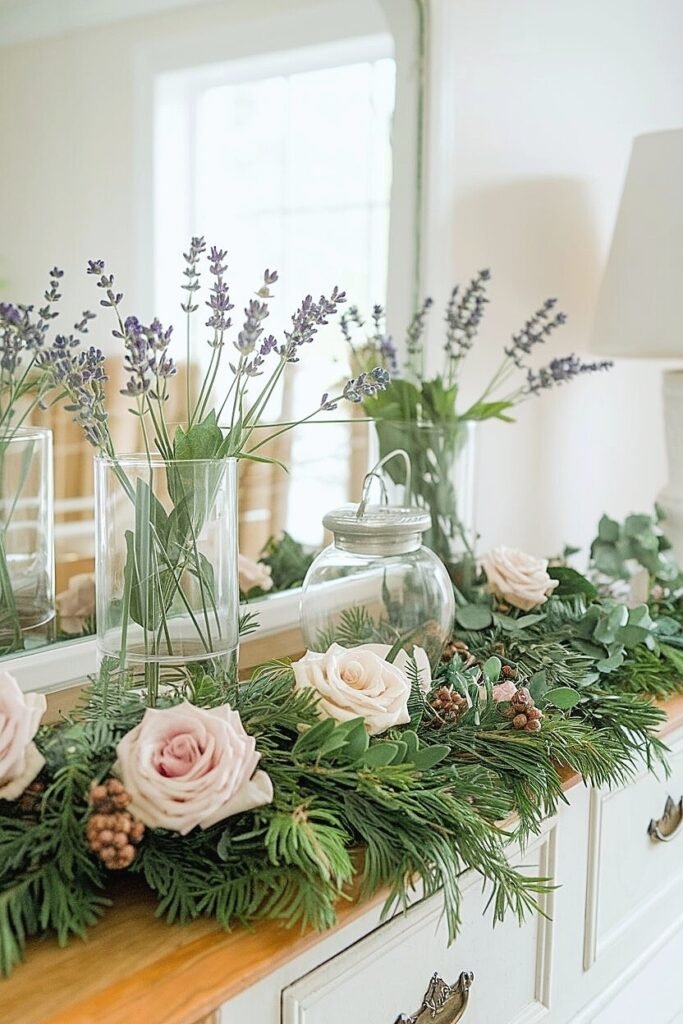
Evergreens do the heavy lifting. I start with noble fir for structure, then soften with cedar’s drape. Eucalyptus (seeded or silver dollar) adds round shapes that complement rose cups, while juniper contributes those dusty berries that harmonize with lavender’s hue.
I keep stems short and wired. Hydrate greens beforehand, mist lightly in the morning, and avoid heat sources. A tidy base makes swapping roses mid-season painless.
I stage in layers: spine, cascade, pockets. Spine = fir tied down with paddle wire. Cascade = cedar sweeping the front edge. Pockets = eucalyptus and boxwood where I’ll seat roses. Lavender nests in last for scent and line.
Hint: Use two backbone greens (fir, cedar) and one or two textures (eucalyptus, boxwood, juniper). Hydrate, wire, and mist to extend life. There’s more composition advice ahead—keep reading for candle integration that won’t scorch petals.
Ways to Mix Candles with Lavender and Roses on a Sideboard
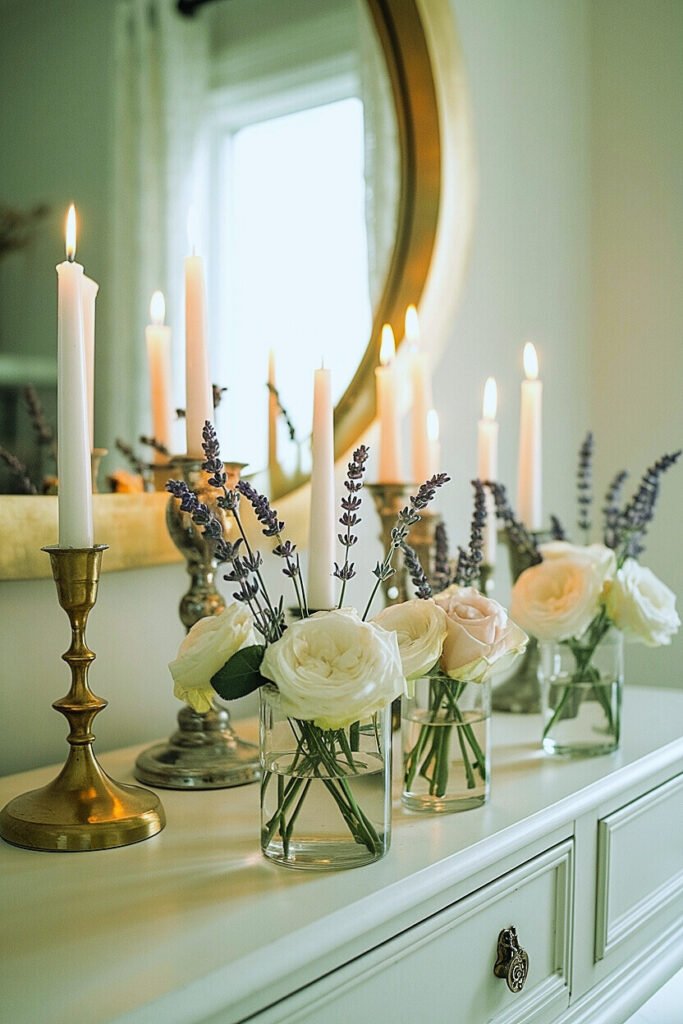
Candles set mood, but heat and soot can ruin petals. I keep flames shielded and distances respectful. Warm white light flatters most palettes; keep scents minimal to avoid clashing with lavender’s herbal note.
I vary heights without blocking sightlines: low votives up front, medium hurricanes midline, and a single taller element off-center for drama.
- Mercury Glass Votives in Trios: Scatter trios every 12–16 inches. The dappled glow flatters rose petals and catches lavender tips. Keep them 6–8 inches from any bloom to prevent heat stress. Use unscented tea lights to avoid fragrance mashups and set on timers for fuss-free evenings.
- Low Hurricanes with Pillars: Small hurricanes corral flame and draft. Choose 3–4 inch pillars at staggered heights. The glass diffuses light, softening the scene while protecting delicate petals and ribbon. Great near the sideboard’s center where you need safe brightness.
- Taper Candles with Bobiches: Slender tapers add elegance. Use drip catchers (Bobiches) and weight the bases. Place behind the floral line so heat vents upward, not into greens. Opt for cream or bone tapers for warmth without color noise.
- Micro-LED Fairy Cloches: Cloches over tiny LED strands create “contained” light that won’t wilt petals. Position near focal roses to halo the blooms. Battery packs hide under greens; warmth stays visual, not thermal.
- Copper Lanterns at the Ends: Flank the setup with small lanterns. Metal warms cool palettes and frames the scene. Keep doors cracked for ventilation and place botanicals outside the heat envelope.
Shield flame, vary heights, and keep a 6–8 inch safety margin from petals. More accessory pairings come next—keep reading for the objects that earn their spot.
What Are the Best Sideboard Christmas Accessories to Pair with Roses and Lavender?
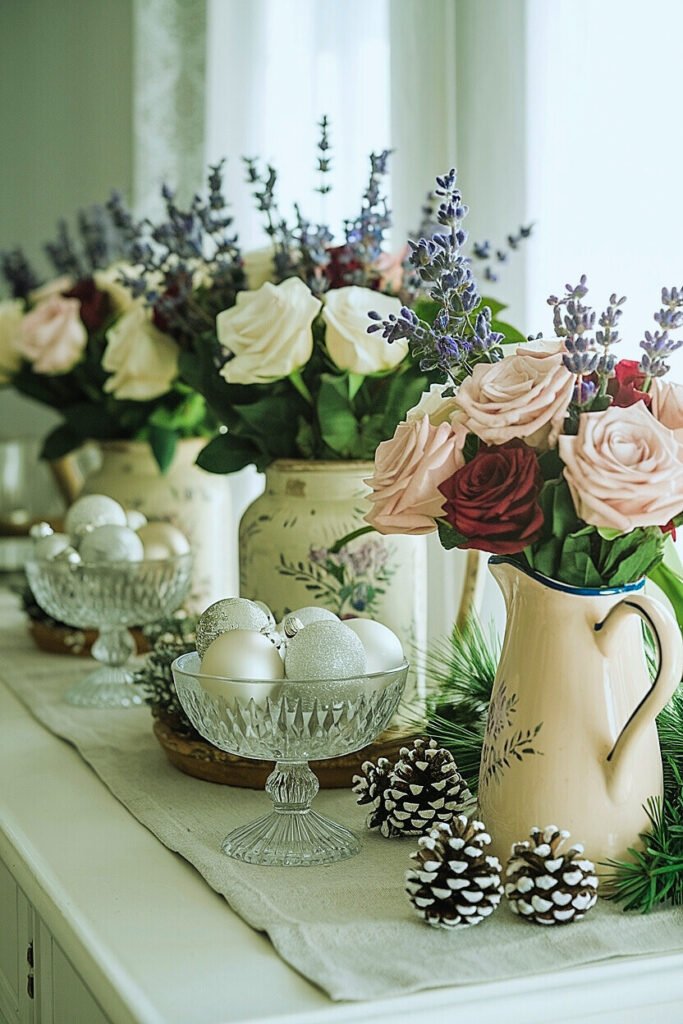
Accessories must support the flowers, not compete. I lean into pieces that add sheen, structure, or narrative—and that photograph well.
I limit to three accessory “voices” so the tableau feels edited. Repetition creates rhythm; scale creates authority.
- Antique Mirror Tray: Corrals bud vases, votives, and micro-LEDs, doubling the glow and tightening the composition. The mirror also visually expands small rooms. Keep it centered or slightly off-center to anchor your “S” curve.
- Mercury Glass Bud Vases: Punctuate the line with small hits of shine. They amplify lavender’s coolness and let you distribute roses without heavy clusters. Ideal for refreshes mid-season.
- Velvet Ribbon Spools: A small stack of ribbon spools (velvet or silk) nods to your palette and adds tactile charm. Tuck a sprig of lavender through the center for continuity.
- Brass or Pewter Bells: Low-profile, matte metals that chime quietly with your ornament choices. They bring holiday story without glitter overload.
- Ceramic Cloches: House micro-lights or a single rose head under glass. They add height without visual weight and protect delicate petals from drafts.
- Linen or Gauze Runner: Softens the surface, absorbs light, and frames the greens. Choose bone, sage, or dove to echo your palette and keep focus on florals.
- Small Wicker Baskets: Weave in texture and warmth. Fill with juniper, lavender bundles, or ornaments to echo the main arrangement without duplicating it.
Choose three accessory types, repeat them with intention, and keep surfaces functional. More on pairing garlands with sideboards is ahead—keep reading.
How to Pair Lavender Garlands with Rustic Christmas Roses
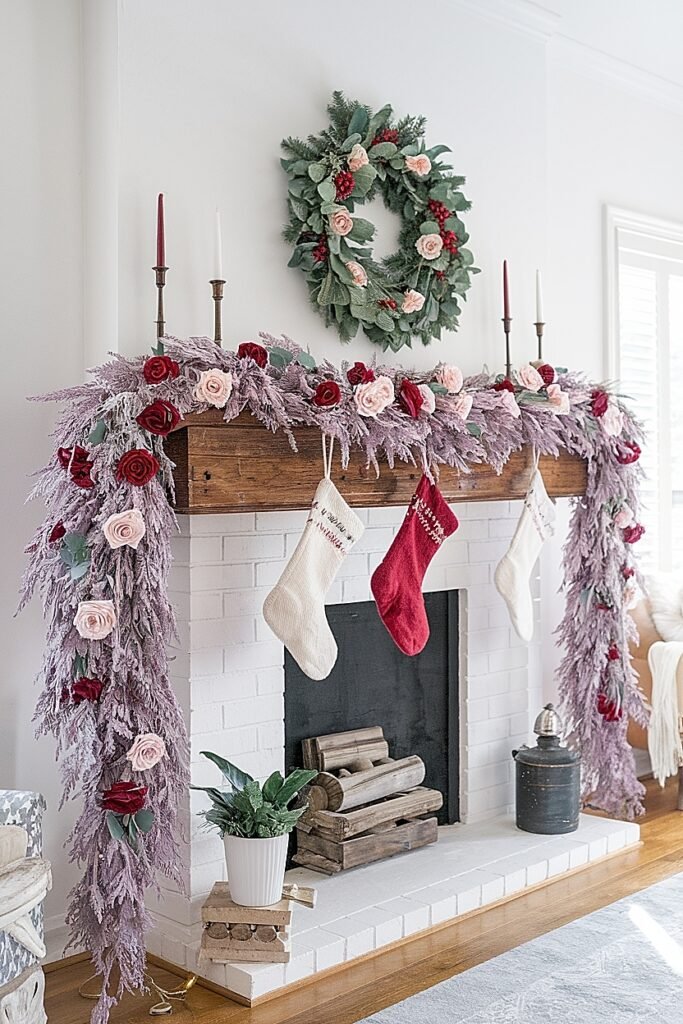
A lavender-forward garland above or behind the sideboard creates context and continuity. I drape a cedar and fir base, then wire short-stemmed roses and add lavender as the final pass. Rustic roses—garden or David Austin–style—read plush against cedar’s fall.
I keep garland tails asymmetrical for a designer look. Lights go in before blooms so I never crush petals reaching for switches.
I align the garland’s visual “weight” with the heaviest part of the sideboard composition. That triangulation makes the room feel intentional rather than decorated piece by piece.
Build the garland first, light it, then echo its palette on the sideboard below. There’s more wreath strategy coming—keep reading for circular statements that link rooms.
What Are the Best Ways to Use Lavender Wreaths with Roses for Christmas?
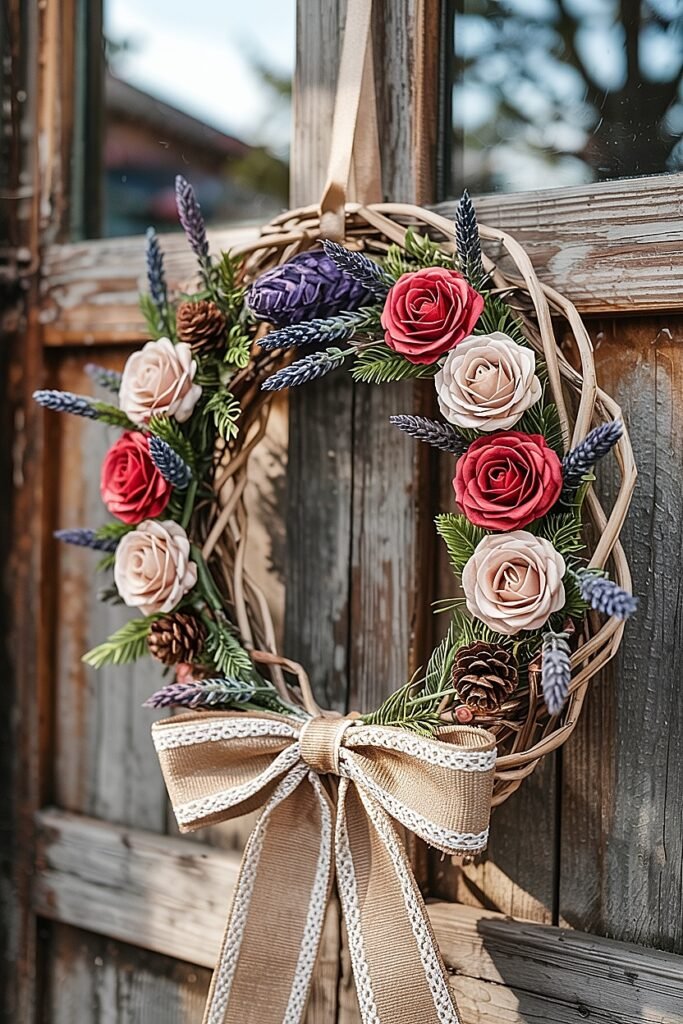
Wreaths add architecture and repetition. On a sideboard wall, they frame the vignette and extend scent into the room. I use foam or grapevine bases, wire short rose stems, and finish with lavender.
I keep wreaths lean to avoid shadow bulk over the florals. Ribbon tails can hint at your color story without stealing the show.
- Over-the-Sideboard Anchor: Hang a 16–20 inch wreath centered above the vignette. Wire in cream roses, lavender, and juniper berries. Add a velvet bow in your metal tone (pewter, champagne) to bridge finishes.
- Twin Mini Wreaths: Flank a mirror with two 10–12 inch wreaths. They echo the sideboard palette and create symmetry without heaviness. Ideal in narrow dining rooms.
- Wreath-on-Easel: Stand a wreath on a small art easel on the sideboard for a sculptural, layered look. It adds height where walls can’t take hooks.
- Ribbon-Suspended Wreath: Suspend from a picture rail with wide ribbon. The vertical line pulls the eye up and makes the arrangement feel grand.
- Candle-Ring Wreath: Use a small lavender-and-rose ring around a hurricane candle on the sideboard. It unifies light and florals in one tight footprint.
Hint: Keep wreaths wired, light in profile, and tuned to your sideboard’s palette. More table-runner guidance is next—keep reading for dining flow.
How to Style Lavender and Rose Table Runners for Christmas Holiday Dining
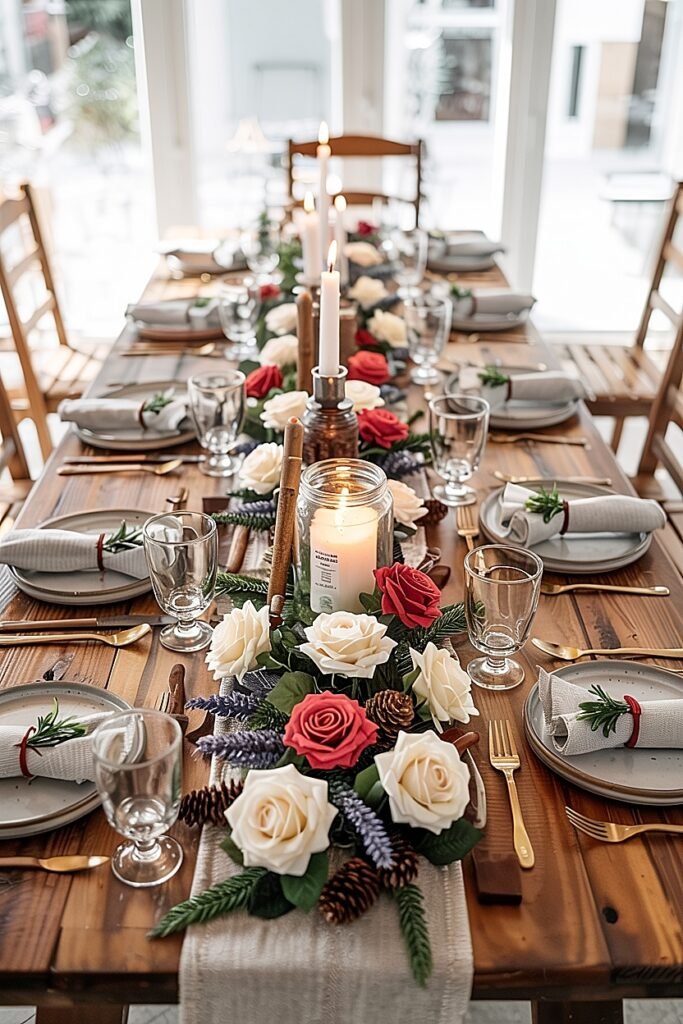
A runner must respect plates and conversation. I build on a narrow board lined with damp wrap, keep height below 8 inches, and alternate rose clusters with open green spaces. Lavender weaves through like cursive, connecting sections.
I swap tall tapers for low, shielded lights to protect petals and sightlines. Place settings get micro-bundles: two lavender sprigs, a rosemary tip, and a name tag.
I maintain cadence: focal every foot, negative space between, repeated metals and ribbon to tie the story together.
Hint: Pre-build the runner, add roses and lavender last, and light with low, warm sources. Keep reading for mantel integration so the whole room sings.
Ways to Use Lavender and Roses in Christmas Mantel Styling
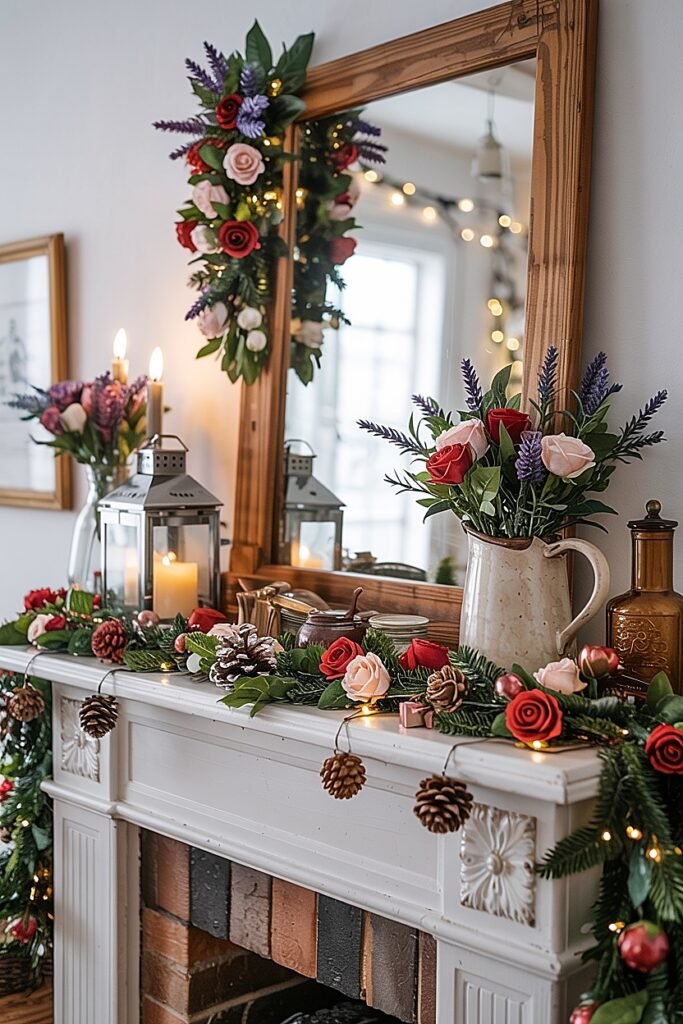
Mantels mirror sideboards; together they define the room. I protect against heat with hurricanes and keep blooms out of the thermal plume. Asymmetry reads modern and intentional.
I tie mantel palettes to the sideboard through repeated metals, matching ribbon, and the same rose-lavender ratio.
- Fir Spine with Cedar Drape: Build structure with noble fir, soften with cedar. Seat roses in clusters, stitch lavender for line.
- Juniper Pockets Near Roses: Echo sideboard berries; they read like built-in ornaments and nod to lavender’s tone.
- Micro-LEDs First, Then Florals: Light the base to avoid crushing petals. Pull a few bulbs forward near focal roses.
- Mercury Glass at Intervals: Low votives add glow without height. Mirror finishes amplify the scene.
- Velvet Figure-Eight Ribbon Tucks: Short pieces wired in for rhythm; tails only at ends to avoid clutter.
- Frosted Glass Near Lights: Diffuse bright points, soften the whole composition.
- Asymmetric Anchor Bow: One larger bow off-center to editorialize the line without covering florals.
Repeat key materials and ratios from the sideboard for cohesion. Keep reading for tree ideas that weave lavender and roses into the bigger story.
What Are the Most Creative Ways to Add Lavender and Roses to a Christmas Tree?
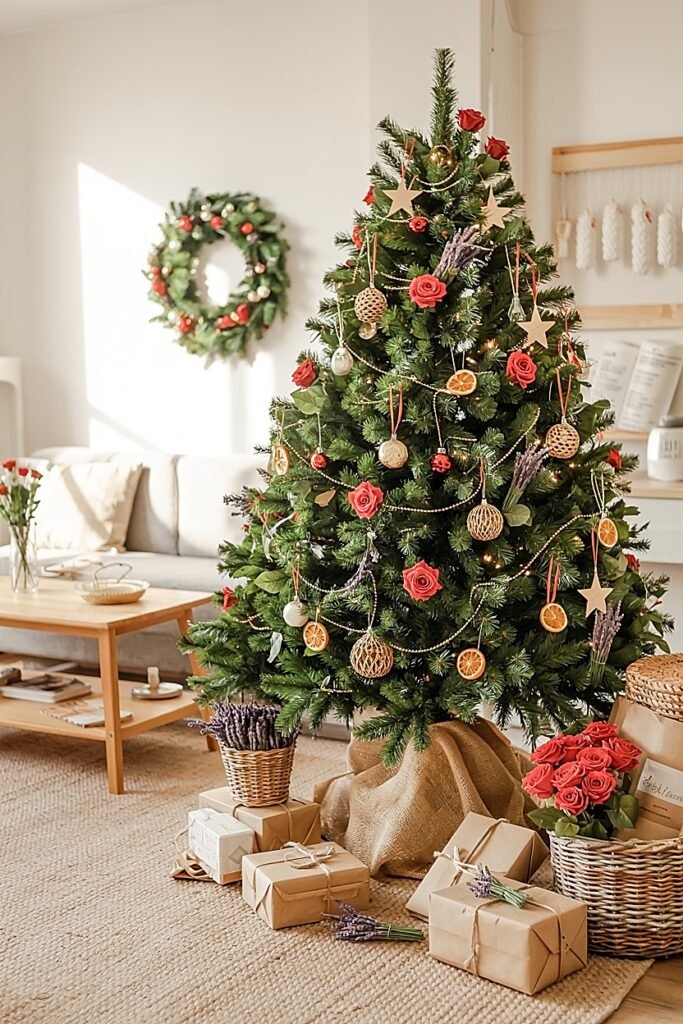
A tree can carry the same fragrance and palette. I wire short lavender bundles into ornament picks and cluster roses where the eye lingers—ends of branches, not just tips.
I balance textures: matte ornaments, mercury accents, velvet ribbon, and tiny lavender sprays near micro-lights for halo effects.
- Lavender Bundle Picks: 3–5 sprigs taped and wired to a pick; tuck behind ornaments for scent and line.
- Rose Clusters at Triangles: Three rose heads wired together and nested deeper on branches for depth.
- Ribbon Weave with Micro Twists: Double-sided ribbon twisted to show both hues; lavender tucked at twist points.
- Juniper and Seeded Eucalyptus Tufts: Echo the sideboard greens; repeat every 18 inches.
- Frosted Drops at Lower Edge: Elongated ornaments draw the eye down; balance with lavender above.
Hint: Translate your sideboard palette to the tree with repeated materials, scaled appropriately. Keep stems short, wire securely, and let fragrance guide placement. More fine-grain tips live throughout this article—keep exploring as you plan.
Conclusion
A polished Christmas sideboard doesn’t happen by accident. Build a green spine, cluster roses for instant focal points, and stitch lavender through for scent and line. Choose a disciplined color story, shield your flames, and repeat materials across the room for cohesion. When you wire cleanly and edit bravely, the space feels curated, calm, and deeply welcoming. Your guests won’t just notice the look—they’ll remember the way the room smelled and the way it made them breathe easier.
This website contains affiliate links, and some products are gifted by the brand to test. As an Amazon Associate, I earn from qualified purchases. Some of the content on this website was researched and created with the assistance of AI technology.
